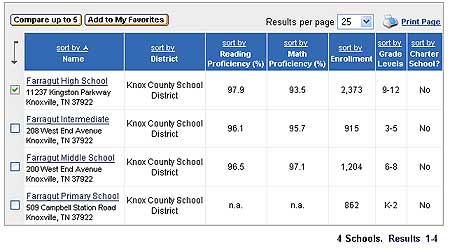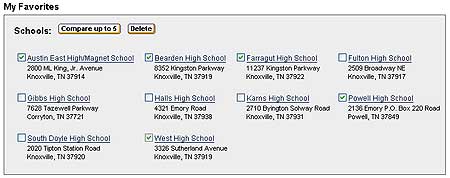Fri
Apr 13 2007
01:28 pm
By: djuggler
I have also created an alternate proposal for rezoning.
Would you like to know how your new school performs compared to others? Visit SchoolMatters and follow the steps outlined after the jump.
You should end up with these results but if you click on the school names and others areas of the table (not mine..your results found at SchoolMatters) you will receive a wealth of information and charts.
| School | Reading | Math | ACT Average |
|---|---|---|---|
| Austin East | 73.9 | 61.7 | 17.4 |
| Bearden | 97.8 | 94.1 | 23.3 |
| Farragut | 97.9 | 93.5 | 23.7 |
| Powell | 90.6 | 89.4 | 21.1 |
| West | 87.5 | 82.6 | 22.1 |
| Fulton | 83.9 | 77.6 | 18.3 |
| Gibbs | 87.0 | 80.6 | 20.3 |
| Halls | 90.4 | 89.2 | 22.0 |
| Karns | 92.7 | 95.2 | 21.4 |
| South Doyle | 85.1 | 79.6 | 20.7 |
| Carter | 90.3 | 87.0 | 20.0 |
| Central | 88.6 | 86.5 | 21.6 |
| Data provided by SchoolMatters, a service of Standard and Poor's. | |||
Click read more for instructons on generating your own comparison...
- Enter the name of a school that interests you.

- Select the appropriate school and click "Add to favorites"

- Click "My Favorites"

- Select 5 schools to compare. Then click "Compare up to 5".

- Enjoy the results. Click everything because much data is beneath the table!

|
Topics:
|
|
Discussing:
- East TN Health Depts. free flu shots today, Oct. 21, 2025 (1 reply)
- Terrible things are happening outside. (3 replies)
- Building housing Knox County Democratic Party headquarters up for sale (3 replies)
- Electricity prices are rising (1 reply)
- Watch how scam victims lose millions to a con with a modern twist (1 reply)
- Knoxville SOUP proposals Announced for Sept. 23, 2025 (1 reply)
- No Kings Rally - Saturday, Oct. 18, 2025 (1 reply)
- Study finds Knoxville has the second worst drivers in the US (3 replies)
- Republicans shutdown government to avoid healthcare support (2 replies)
- Well, isn't that special? (1 reply)
- Serious Budgeting Yes, Silly Pandering No (1 reply)
- What's that being built near the entrance to Fort Dickerson Park? (8 replies)
TN Progressive
- WATCH THIS SPACE. (Left Wing Cracker)
- Report on Blount County, TN, No Kings event (BlountViews)
- America As It Is Right Now (RoaneViews)
- A friend sent this: From Captain McElwee's Tall Tales of Roane County (RoaneViews)
- The Meidas Touch (RoaneViews)
- Massive Security Breach Analysis (RoaneViews)
- (Whitescreek Journal)
- Lee's Fried Chicken in Alcoa closed (BlountViews)
- Alcoa, Hall Rd. Corridor Study meeting, July 30, 2024 (BlountViews)
- My choices in the August election (Left Wing Cracker)
- July 4, 2024 - aka The Twilight Zone (Joe Powell)
- Chef steals food to serve at restaurant? (BlountViews)
TN Politics
- Memphis Democrat’s bill would allow recall of local elected officials (TN Lookout)
- Shutdown on day 22 sets record as second-longest in US history, with no sign of a deal (TN Lookout)
- Mayor Young tells Hispanic leaders Memphis Police Department is working with ICE (TN Lookout)
- Signaling skepticism that exceptions to TN abortion ban are adequate, judges rule against state (TN Lookout)
- Trump seeks to approve his own $230M payback from DOJ over past probes (TN Lookout)
- John Cole’s Tennessee: Spooky season (TN Lookout)
Knox TN Today
- A family, a camera, some patience: An unforgettable sunset (Knox TN Today)
- The eyes have it (Knox TN Today)
- Vitello move from Vols to Giants shakes up baseball (Knox TN Today)
- Rick Meredith + Chrystal Armstrong Brown + Steve Krempasky + BarberMcMurry/ PSCC (Knox TN Today)
- HEADLINES: World news to local BBB scam warning & Vitello gone (Knox TN Today)
- Let’s ‘Give a Hoot’ for Owl Ridge Raptor Center (Knox TN Today)
- Weekend Scene from Haunted History Hike to Hippie Sabotage (Knox TN Today)
- Premier Surgical welcomes new CEO (Knox TN Today)
- Chamique Holdsclaw to keynote VMC fundraiser (Knox TN Today)
- Strong property sales continue in Knox County (Knox TN Today)
- Wallace Real Estate supports ‘Making Strides Against Breast Cancer Walk ‘ (Knox TN Today)
- Annual Bazillion Blooms Campaign encourages tree planting across East Tennessee (Knox TN Today)
Local TV News
- Maryville College receives $12M from state for Appalachia-focused science center (WATE)
- Development projects underway in downtown Newport one year after Helene (WATE)
- Free support groups, classes help East Tennesseans face cancer together (WATE)
- By the numbers: Tony Vitello's record-breaking career at Tennessee (WATE)
- Harbours Gate's annual luncheon fundraiser supports mission of second chances (WATE)
- $63,000 grant to fund improvements at Muse Knoxville (WATE)
News Sentinel
State News
- Geraldine Chambers - Chattanooga Times Free Press (Times Free Press)
- Marsha Bryant - Chattanooga Times Free Press (Times Free Press)
- Chattanooga Now Events - Valleybrook Townhomes Community Wide Yard Sale - Chattanooga Times Free Press (Times Free Press)
- Some Chattanooga VW workers say they’re ready to accept a deal, others loudly disagree - Chattanooga Times Free Press (Times Free Press)
Wire Reports
- Stock futures are little changed as investors digest earnings, trade news: Live updates - CNBC (Business)
- Trump plans to send federal agents to San Francisco ‘right out of dictator’s handbook’, says Newsom – US politics live - The Guardian (US News)
- Stock Market Today: Oil Prices Jump, Dow Futures Waver— Live Updates - The Wall Street Journal (US News)
- U.S. kills five on alleged drug boats in Pacific, widening Trump’s campaign - The Washington Post (US News)
- How Senate Republicans finally said 'no' to Ingrassia - Politico (US News)
- At least 25 states plan to cut off food aid benefits in November - Politico (US News)
- White House East Wing will be torn down fully to make way for Trump ballroom - Reuters (US News)
- Elon Musk got feisty about his $1 trillion pay package in the final minutes of Tesla's earnings call - businessinsider.com (Business)
- Gold Extends Pullback from Record High for a Third Day - Bloomberg.com (Business)
- 7 Takeaways From the Final N.Y.C. Mayoral Debate - The New York Times (US News)
- TikTok creator and US marshal shot during LA immigration raid - BBC (US News)
- Exclusive | Trump Administration in Talks to Take Equity Stakes in Quantum-Computing Firms - WSJ - The Wall Street Journal (Business)
- Amazon claims the headline isn’t robots taking jobs as it reveals new cost-cutting robots - The Verge (Business)
- Tesla profit falls short despite record sales, hit by higher costs and fading credits - Reuters (Business)
- Why Beyond Meat shares have surged 1,000% in four days - BBC (Business)
Local Media
Lost Medicaid Funding
To date, the failure to expand Medicaid/TennCare has cost the State of Tennessee ? in lost federal funding. (Source)
Search and Archives
TN Progressive
Nearby:
- Blount Dems
- Herston TN Family Law
- Inside of Knoxville
- Instapundit
- Jack Lail
- Jim Stovall
- Knox Dems
- MoxCarm Blue Streak
- Outdoor Knoxville
- Pittman Properties
- Reality Me
- Stop Alcoa Parkway
Beyond:
- Nashville Scene
- Nashville Post
- Smart City Memphis
- TN Dems
- TN Journal
- TN Lookout
- Bob Stepno
- Facing South

Thanks for the link. I am
Thanks for the link.
I am always a little disappointed at seeing South-Doyle's statistics. I attended there when it was Doyle and thought it a pretty good school.
I compared South-Doyle to Bearden and Farragut.
Something is going on out there in SoKno County.
The ACT Participation Rate is only 53.5% at South-Doyle versus 70.8% at Bearden and 78.1% at Farragut. That is a pretty huge difference.
Cool, but...
Interesting, but not sure where these results came from.
TCAP scores?
Where the scores come from...
I think they come from the results of ACT testing..
ACT
A standardized assessment that measures students' general educational development and readiness to pursue college-level coursework in English, reading, mathematics, and science. The possible scores range from 1 through 36 for each of the four subjects. Because the ACT is based on high school curriculum, student performance on the test does not reflect innate ability and is influenced by students' educational preparedness. The ACT is administered in 50 states; and, in about 25 states more than half of all high school students who graduate take the test.
From the help section
And the data: